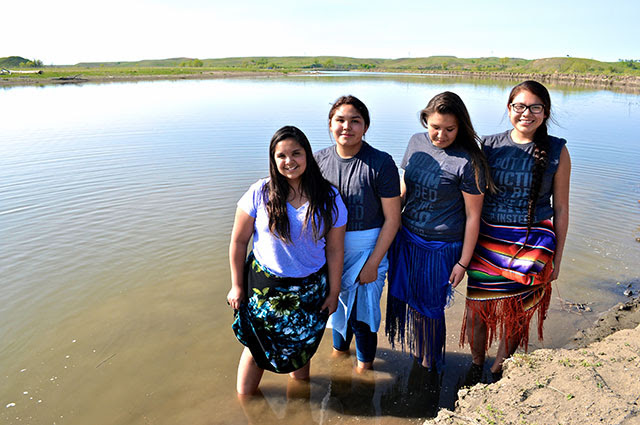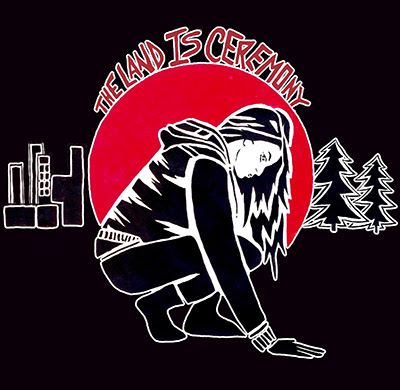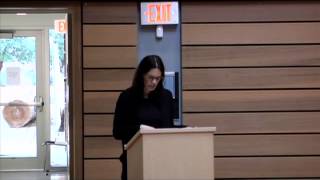 Rezpect Our Water campaign youth leaders (left to right) Tokata Iron Eyes, AnnaLee Yellow Hammer, Precious Winter Roze Bernie and Winona Gayton stand in defense of land and water. (Photo: Kettie Jean)
Rezpect Our Water campaign youth leaders (left to right) Tokata Iron Eyes, AnnaLee Yellow Hammer, Precious Winter Roze Bernie and Winona Gayton stand in defense of land and water. (Photo: Kettie Jean)
“Climate change is the defining issue of our time.” These urgent words came from 16-year-old Xiuhtezcatl Roske-Martinez, a young Indigenous man raised in the Aztec tradition, at a United Nations General Assembly event on climate change held on June 29, 2015. Roske-Martinez is the youth director for Earth Guardians, a nonprofit organization centered on galvanizing global youth leadership to defend the planet for current and future generations. He is mobilizing youth through school-based presentations, legal challenges, eco hip-hop and public talks — elevating the voices of young people near and far and empowering them to become forces of change in their own right.
Upon learning the federal courts upheld the rights of youth on April 8, 2016, in a landmark constitutional climate change case brought forward by Our Children’s Trust (representing 21 youth plaintiffs) against the US federal government and fossil fuel industry, Roske-Martinez made the following public statement:
When those in power stand alongside the very industries that threaten the future of my generation instead of standing with the people, it is a reminder that they are not our leaders. The real leaders are the twenty youth standing with me in court to demand justice for my generation and justice for all youth. We will not be silent, we will not go unnoticed, and we are ready to stand to protect everything our “leaders” have failed to fight for. They are afraid of the power we have to create change. And this change we are creating will go down in history.
And change things they will.
Roske-Martinez is not alone in his pursuit of environmental justice through the harnessing of young people’s power, experiential knowledge and visioning of a future world where balance has been restored on Earth. He is part of a growing battalion of Indigenous youth warriors railing against the failure of governments, fossil fuel companies, domestic and international monitoring agencies, and human rights organizations to acknowledge the grave environmental destruction surfacing in the wake of Western-born models of industrialization and to be accountable around climate recovery. They are calling out the relentless rise of a global, capitalist social order promoting an extreme form of economic growth that results in the skyrocketing of wealth for few at the great expense of many.
Demanding the environmental movement contend first and foremost with the fundamental linkages between colonialism and climate change, Indigenous youth across Native North America are mounting resistance efforts to protect their ancestral homelands from further exploitation. This is a timely endeavor, as natural gas and oil extraction continue unabated throughout Turtle Island, with lethal aftereffects, as recently witnessed with the Fort McMurray wildfire that burned the city to the ground. Simultaneously, Indigenous youth are developing locally based solutions to address the toxic impact of extractive processes on their communities. Indigenous Nations are often situated on the frontlines and forced to deal with the immediate fallout of environmental degradation such as contaminated soil, open-air wastewater pits and poisoned water sources. For Indigenous peoples, youth have always been at the heart of society, and future generations are a key motivation for the practice of maintaining balance with the world of relations.
These young people are bold and brave. They are innovative and imaginative. And they are organizing through an arsenal of tactics that reflect a profound and intergenerational commitment to the land, water and air upon which everything is dependent — the sacred building blocks of life itself. It’s a commitment, in fact, that predates the colonial founding of the settler states of Canada and the USA.
 Violence on the Land, Violence on Our Bodies Artwork, Native Youth Sexual Health Network. (Image: Konsmo)Violence on the Land, Violence on Our Bodies
Violence on the Land, Violence on Our Bodies Artwork, Native Youth Sexual Health Network. (Image: Konsmo)Violence on the Land, Violence on Our Bodies
On June 6, 2016, the Native Youth Sexual Health Network (NYSHN), in partnership with Women’s Earth Alliance (WEA), released a report and toolkit entitled “Violence on the Land, Violence on our Bodies: Building an Indigenous Response to Environmental Violence.” The multiyear initiative aims to articulate an explicit connection between violence on the land and violence to the body by exposing how strategies of colonization, genocide and ecocide hinge on the very intersection between Indigenous territory and people. As a staff member from NYSHN told Truthout, “This resource was built by community to help to continue mobilizing responses
The report underscores the systematic environmental violence experienced by Indigenous communities continuing to live under conditions of occupation. It also showcases the widespread resistance efforts that mark a clear distinction between Indigenous ways of being in relation to the land and those perceptions held by settlers, the latter being heavily influenced by the principle of terra nullius outlined in the Doctrine of Discovery, which was used to justify the seizure and subsequent desecration of Native lands more than 500 years ago. Terra nullius is a Latin phrase meaning “nobody’s land,” a colonial invention of European international law legitimating the idea that any land deemed “unoccupied or unsettled” could be acquired as a “new territory” by a sovereign state, and that the laws of that state would apply in the new territory.
NYSHN is a grassroots network by and for Indigenous youth that works across issues of sexual and reproductive health, rights and justice in the United States and Canada. To create the report, members of NYSHN travelled to some of the most severely impacted Indigenous homelands to document the lived realities on the frontlines. They uncovered stories about how extractive industries have drilled, mined and fracked on lands near resource-rich Indigenous territories for decades.
These energy projects have resulted in massive economic gains for transnational corporations, but have come at a significant cost to Indigenous peoples, disproportionately impacting Indigenous women, two-spirit people and youth. As Amanda Lickers (Turtle Clan, Seneca), a youth participant and advocate working with NYSHN, puts it, “The reason women [are] attacked is because women carry our clans. That’s where we get our identity as nations. So if you destroy the women, you destroy the nations and then you get access to the land.” The multilayered wreckage caused by environmental violence is broad ranging and devastating in scope — gender violence, higher rates of drug and alcohol abuse, murders and disappearances, reproductive illness and toxic exposure, direct threats to culture and Indigenous lifeways, and an undermining of Indigenous political claims to governance and self-determination all reared their ugly heads in the report.
The testimonies also make it clear that the inception of this environmental violence first found its footing in the equally abhorrent processes of conquest and domination over nature that was necessary to bring Canada and the United States into being — a realization that takes the founding of the Native environmental justice movement back to 1492. “We are talking about how we experience climate change and environmental destruction as a direct result of colonization,” Lickers told Truthout in an interview about the project. “The root problem is not climate change per se, the root problem is the occupation of our territories and these anti-Indigenous world views that see the natural world as separate from human existence.” Indigenous-youth-led organizations such as NYSHN, then, are doing the important work of challenging the political vernacular and analytic focus within the dominant climate justice movement — a movement that exercises deliberate amnesia about the complex and colonial power structures and legacies that have driven the world to the current ecological crisis in which we are all located — by placing an anti-colonial and gendered critique at the center of deliberations over climate crisis.
No More Pipelines
Across the plains of North Dakota, Indigenous youth have been speaking truth to power by attempting to stop the building of the Dakota Access Pipeline, a project of Dallas-based Energy Transfer Partners. If approved, the pipeline would transport oil from the Bakken region of North Dakota across four states to Pakota, Illinois through a route that traverses underneath the Missouri River twice and runs alongside the Standing Rock Reservation.
The Standing Rock Sioux get their drinking water from the Missouri River. Consequently, the proposed pipeline serves as a direct threat to their water sources and would be an environmental assault on the community if a spill were to occur. Energy Transfer Partners has assured the people of Standing Rock that the pipeline would be closely monitored, but given the historical relations between Indigenous peoples and the United States, the tribe has little faith that their safety and interests will be upheld. The record on spillage is bleak. In 2012-2013, there were 300 oil pipeline breaks in North Dakota alone.
When Indigenous youth in the region heard about the pipeline proposal, they initiated a campaign called Rezpect Our Water to make their voices heard, raise public awareness, and ultimately halt the pipeline project. Drawing on oral histories of Indigenous political resistance in her homelands, Tokata Iron Eyes, a 12-year-old Lakota young woman and one of the lead youth organizers in the campaign, explained to me her motivation for joining the struggle: “Our ancestors are the ones that died fighting for this land, so that makes me think that we have a duty to fight for our land. And we are obligated to protect the soil and the water and everything that is sacred like that. Whatever happens with the pipeline and climate change — that is going to be affecting us, this generation. And it will affect the next generation too.” Tokata and her youth comrades are holding rallies, organizing spiritual relay runs, educating through formal and informal teach-ins, writing letters, circulating petitions, and creating videos to get their message out and to remind the broader public that the United States is still, and has always been, Indigenous land.
The role of Indigenous young women coming together in this campaign has also been paramount, signaling the enduring strength of Indigenous women’s leadership in questions of tribal governance. “Women were the people who held the tribe together and they were the willpower of the tribe and its strength. So, just knowing that we come from such powerful genes makes us feel strong inside,” Tokata offered in an interview with Truthout. “So I feel that even if the men aren’t fighting for us and our land, then we as young women have an obligation to fight for ourselves and our people. I feel like I need to fight for my kids and my grandchildren, and my grandmas who can’t fight for themselves anymore.”
Decolonization and Indigenous Resurgence: The Path to Real Climate Justice
The work of these Indigenous young people demands a critical evaluation of the construction of the climate justice movement. The colonial violence that fostered the ruination of the planet in the first place has, for the most part, been blurred out of focus in public dialogue on this topic. An accurate examination of the social and political causes of climate change requires a close look at the history of genocide, land dispossession and concerted destruction of Indigenous societies and cultural practices that has come alongside the irreversible damage wrought by environmental destruction.
Siku Allooloo, an Inuit-Taino writer and community organizer from Denendeh (Northwest Territories, Canada), recently gave a keynote at the 2016 Girls Climate Summit in Philadelphia, Pennsylvania, where she spoke about her work bringing youth and elders together on the land to discuss climate change impacts on their ways of life. In an interview with Truthout, Allooloo said:
Indigenous peoples are living with the overlapping effects of colonialism, industrial exploitation and climate change. However, we retain a powerful commitment to protecting all that generates life, both within our ancestral practices and the life-giving forces within the land. This is why Indigenous peoples throughout the world — and primarily Indigenous women and girls — are at the very forefront of movements for decolonization and climate justice.
She urged the delegates, ages 9 to 18, to place these realities front and center in their strategizing around climate justice.
As each of these young leaders have made evident, this is not only a fight about climate, but also an ancient, anti-colonial fight over the seizure of land and its translation into a commodity that can be bought and sold, the exploitation of Earth and air resources, and the elimination of entire peoples for the pursuit of conquest and profit.
It is not enough to protect the environment from grave industrial harm; we must also dismantle the very systems from which these industries stem — systems that perpetuate violence against humans and homelands alike. As such, climate justice organizing must go hand in hand with decolonization efforts by fostering and growing the leadership of Indigenous youth, supporting large-scale land restitution projects for Indigenous Nations, reinforcing the revitalization of Indigenous governance systems and channeling resources into the frontline resistance of Indigenous peoples across Turtle Island.
Simply put: Close attention must be paid to the wisdom and knowledge of Indigenous youth and their communities as they attempt to heal and protect our planet from the harm that comes in the wake of a never-ending demand for more energy, regardless of the cost.
Copyright, Truthout. May not be reprinted without permission.
Jaskiran Dhillon is a first generation academic and advocate who grew up on Treaty Six Cree/Métis Territory in Saskatchewan, Canada. Her work spans the fields of settler colonialism, anthropology of the state, anti-racist feminism, colonial violence and youth studies. Her first book, forthcoming with University of Toronto Press in 2017, Prairie Rising: Indigenous Youth, Decolonization, and the Politics of Intervention, provides a critical, ethnographic account of state interventions in the lives of urban Indigenous youth. She is currently an assistant professor of global studies and anthropology at The New School in New York City.

Preview YouTube video Respect Our Water: Sign our petition















